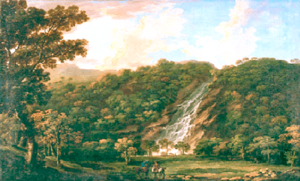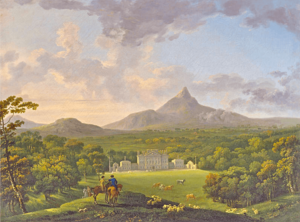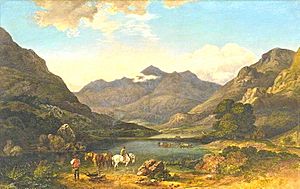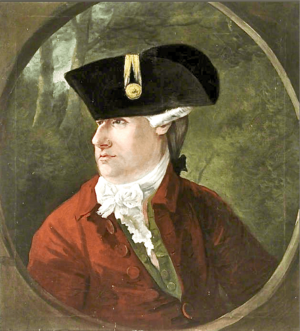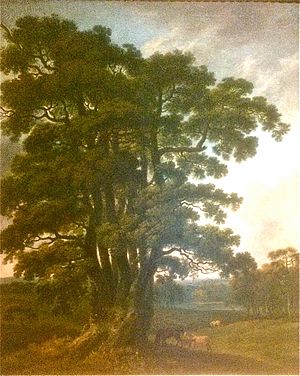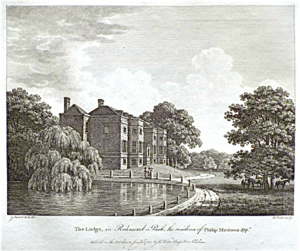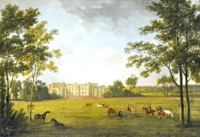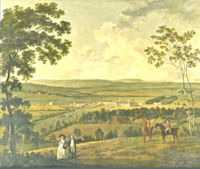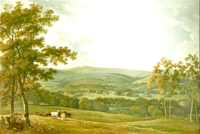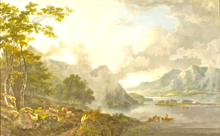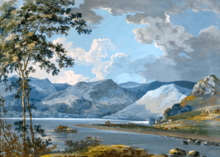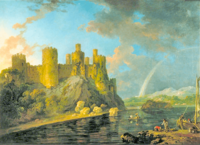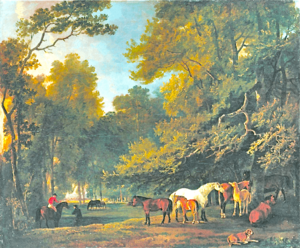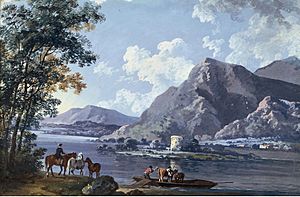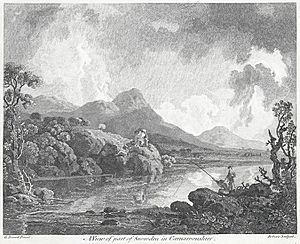George Barret Sr. facts for kids
Quick facts for kids
George Barret (Senior)
|
|
|---|---|

Beeston Castle, Cheshire, c. 1770
|
|
| Born |
George Barret
Either 1728 or 1732 |
| Died | 1784 |
| Nationality | Irish |
| Education | Robert West and James Mannin |
| Known for | Landscape paintings |
| Movement | Founding member of the Royal Academy |
| Patron(s) | Lord Powerscourt, William Cavendish-Bentinck, 3rd Duke of Portland William Lock of Norbury Park, William Constable of Burton Constable. |
George Barret Sr. RA (born around 1730 – died 29 May 1784) was a famous Irish artist. He was known for his beautiful landscape paintings, especially using oil paints and watercolors.
In 1762, George Barret moved from Ireland to London to become a successful artist. He quickly became very well-known. He showed his paintings at the Society of Artists of Great Britain. Many important art collectors, called patrons, bought his work. In 1768, Barret and other leading artists helped start the Royal Academy. This was a very important art group. He continued to show his paintings there until 1782.
Barret traveled a lot around England, Wales, and Scotland to paint for his patrons. He painted places like the Lake District and the Isle of Wight. He didn't seem to travel outside of Britain. Some paintings of Tivoli in Italy were thought to be his, but they were probably painted by his son, George Barret Jr. Barret had asthma, a breathing problem. Because of this, he moved to Westbourne Green in 1772. At that time, it was a quiet country village outside London.
Even though he earned a lot of money from his paintings, he wasn't very careful with it. In 1782, his friend Edmund Burke helped him. Burke had known Barret since they were young in Dublin. Thanks to Burke, Barret got a job as the master painter at Chelsea Hospital. He kept this job until he died in 1784. After he passed away, his wife and children didn't have much money. But the Royal Academy gave his wife a yearly payment to help them.
Contents
- Life Story of George Barret
- Later Life and Collaborations
- Watercolors, Gouache, and Prints
- His Art Today
Life Story of George Barret
Early Life in Ireland
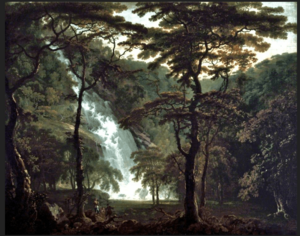
George Barret was born in Dublin, Ireland, between 1728 and 1732. His father was a cloth merchant. George first started working as an apprentice to a staymaker, someone who made stiff parts for clothes.
By 1747, he began learning to draw at an art school in Dublin called Robert West's academy. Later, he studied with another teacher named James Mannin. After finishing his studies, he taught drawing at the same academy.
He was friends with Edmund Burke, who later became a famous writer and politician. Burke wrote a book about beauty and art in 1757. You can see Burke's ideas in some of Barret's early paintings, like the Powerscourt Waterfall. A version of this painting, now in Liverpool, is believed to have been painted for Edmund Burke himself.
Paintings Inspired by Italy
Early in his career, Barret painted many scenes that looked like classical Italian landscapes. These often included figures from old myths. Even though there's no proof he ever went to Italy, most of these paintings were made for homes in Ireland.
Barret often got ideas for his early landscape paintings from copies of famous Italian scenes by artists like Claude Lorrain. For example, two of his paintings, sold in 2013, were based on copies of Claude Lorrain's works. One of these paintings even showed the image reversed! Barret also painted other Italian-style scenes with old ruins before he started focusing on Irish landscapes.
His first big supporter was probably Joseph Leeson, 1st Earl of Milltown. Leeson built a grand house called Russborough House in County Wicklow, Ireland. He filled his house with a large art collection, including many of Barret's paintings. These paintings were used to decorate the dining room. Many of Barret's works from this collection are now in the National Gallery of Ireland.
Barret also used ideas from engravings by Giovanni Battista Piranesi, which were published in 1748. One landscape painting he made for Thomas Taylour, 1st Earl of Bective was based on a temple in Italy.
Irish Landscapes and Patrons
After working for Samuel Madden and the Earl of Milltown, Barret began painting real Irish landscapes. These showed actual places, not made-up scenes. This was a natural step from his earlier Italian-style paintings.
Barret is especially linked to Edward Wingfield, 2nd Viscount Powerscourt. In 1751, Wingfield became Viscount Powerscourt. He owned Powerscourt House and large lands south of Dublin in County Wicklow. These lands included the beautiful River Dargle with its rocky cliffs and the impressive Powerscourt Waterfall, which is the second highest in Ireland. Scenes from the Dargle river often appear in Barret's paintings. He also painted in Avoca.
A painting called View of Powerscourt House under the Sugar Loaf Mountain is now in the Yale Center for British Art. Another version of Barret's Powerscourt Waterfall is in the National Gallery of Ireland.
Barret was likely introduced to the Marquess of Rockingham by his friend Edmund Burke, who worked for the Marquess. Barret was hired to draw the remains of Killtimon Castle in County Wicklow.
Another Irish supporter of Barret was Thomas Conolly (1738–1803) of Castletown House. Barret painted a picture of Castletown House in the distance, surrounded by trees and a river. This painting is described as soft and atmospheric.
Since he couldn't find enough work in Ireland, Barret moved to London in 1762.
Moving to England and Gaining Support
After moving to London in 1762, Barret quickly became a leading landscape artist. In 1764, he showed his work at two art societies. He won a prize for his painting Large Landscape with Figures, which was later bought by the Marquess of Rockingham. At another exhibition, he showed paintings of the Dargle river and Powerscourt Waterfall, which he had brought from Ireland.
In 1768, a disagreement happened within the Society of Artists. Barret suggested that a group of artists, led by Sir William Chambers, ask the King to create the Royal Academy. Barret was named as one of the founding members. He was especially good at painting wild and mountainous natural landscapes. More than a third of the 31 paintings he showed at the Royal Academy between 1769 and 1782 were of such scenes. He sometimes painted portraits, like the one of William Constable. He also painted animals, such as a water spaniel belonging to Lord Edward Bentinck.
When he arrived in London, Barret used his connections from Ireland, especially with the group around the Marquess of Rockingham. Rockingham became prime minister twice. Through Edmund Burke, Rockingham's secretary, many important people like the Duke of Portland and Sir George Colebrook bought paintings from Barret. His supporters were mostly rich landowners who wanted paintings of their estates and parks.
Barret soon had many painting jobs. It was said he earned a huge amount of money for an artist at that time. People described Barret as a friendly person who got along well with others. Many landowners who supported Barret were building grand new houses that needed large paintings to decorate their rooms.
The Duke of Portland asked Barret to paint a dozen pictures of trees and landscapes at Welbeck Abbey. Barret painted these between 1765 and 1771 and was paid well for them. Most of these paintings are now on display at the Portland Gallery at Welbeck.
Paintings for Sir Peter Leicester
A list of paintings from 1821 mentions a painting by Barret in the collection of Sir John Leicester. This painting showed a view of Beeston Castle. It might have been a pair with another painting of Beeston Castle by Barret. Sir John Leicester's father, Sir Peter Byrne Leicester, might have owned this painting. This could connect Barret to an Irish family, as Sir Peter Byrne Leicester had Irish roots.
Barret also painted for the Duke of Buccleuch from about 1768 to 1771, likely for Dalkeith Palace. His painting Part of Melrose Abbey by Moonlight is now at Drumlanrig Castle. Art expert Ellis Waterhouse noted seven views of Dalkeith Park by Barret. Waterhouse said these were his most memorable works, showing a unique British landscape style.
George Keppel, 3rd Earl of Albemarle, a military leader and supporter of Rockingham, also bought paintings from Barret. Albemarle lived at Bagshot Park. One painting he ordered was The Long Walk, Windsor, with Brood Mares and Foals, which included the famous racehorse Eclipse. This painting was later bought by Queen Victoria.
Barret also painted several scenes around Lowther Castle in Westmorland for the Lowther family. In one painting, the people were painted by Philip Reinagle and the dogs by George Stubbs.
Sir George Colebrooke, a London banker and chairman of the East India Company, also commissioned at least two paintings from Barret for his home, Gatton Park. Colebrooke had hired Capability Brown to design the landscape at Gatton. One of Barret's paintings, sold in 2013, shows workers finishing the landscaping. This painting shows Barret being influenced by another artist, Richard Wilson, and focusing on beautiful scenes around a lake.
William Lock, an art expert, had a new house built at Norbury Park in 1774. Barret helped paint a special room there called the Painted Room. In this room, Barret worked with other artists. They painted scenes of distant countryside on the walls, making it look like an open arbour. Barret also painted a picture of the tree-lined driveway at Norbury Park, which is now in Norwich Castle Museum.
Philip Medows and Views of Richmond
Another person who supported Barret was Philip Medows, who was in charge of Richmond Park. An old print from 1779 shows the Richmond Lodge, which suggests Barret painted a picture of this building. Barret also painted many views of the River Thames near Richmond Hill.
William Constable of Burton Constable Hall
Records show that in 1776, Barret was paid to make drawings for William Constable. In 1777, he was paid for three landscape paintings of Burton Constable Hall. These paintings are still at Burton Constable, and one shows the house with parkland. There is also a portrait of William Constable by Barret in the house.
Work in Hampshire and the Isle of Wight
In the mid-1770s, Barret worked for people in Hampshire and the Isle of Wight. For example, a painting in the National Gallery of Scotland shows the Thistlethwaite family with their house, Southwick Park, behind them. This painting is similar to the Burton Constable Hall painting.
Charles Townley
It's likely that Charles Townley, a famous collector, also supported Barret. Townley probably asked Barret to paint his country house, Towneley Hall, after returning from his travels in the mid-1770s. This painting is typical of Barret's later work, showing the house in the center, framed by trees. It is now in the Towneley Hall Museum and Art Gallery.
Later Views of the Lake District
In 1781, Barret showed a painting at the Royal Academy called View of Windermere Lake in Westmoreland. This painting showed the sun rising and mist clearing. It might be the same painting that is now in the National Gallery of Victoria, Australia. Barret seems to have visited the Lake District in 1781. He painted other versions of this view, which shows Belle Island, and other scenes of Windermere and Ullswater.
In the 1770s, the Lake District became a popular place for tourists and artists. Barret likely sold these paintings to tourists who had visited the Lakes. Belle Isle, the largest island in Lake Windermere, was bought in 1772. A round house was built there, which you can just see in the painting.
Paintings of Wales
George Barret created a notable series of paintings of Welsh scenery. Some of these look quite similar to paintings by Richard Wilson. A few might have been done soon after Barret arrived in England. For example, an oil painting of Hawarden Castle was shown in 1765. However, most of Barret's Welsh paintings were probably made later in his life. In the mid-1770s, Wales became a very popular place for wealthy tourists.
In 1777, Henry Penruddocke Wyndham toured Wales with a Swiss artist named Samuel Hieronymus Grimm. Wyndham's book about his tour, published in 1781, was the first guidebook with pictures of Welsh scenery. Barret's surviving paintings suggest he took a similar trip, starting in the south. Many of his paintings are from similar viewpoints to Grimm's. The Government Art Collection has Barret's oil paintings of the Severn and Wye rivers meeting, and Cilgerran Castle. He also painted scenes in Snowdonia, including Snowdon from Llyn Nantle and Llyn Padarn. Unlike Richard Wilson, he didn't paint Caernarfon Castle, but he made at least five different versions of a painting of Conway Castle.
Later Life and Collaborations
Around 1770, Barret lived in Orchard Street in London. He was linked to Edward Augustus Stratford, a young nobleman who was developing land in London. Stratford laid out Stratford Place, a street of grand houses. It was said that Stratford learned about the building site from Barret.
Later in his life, Barret became poorer. He had to sell the contents of his art studio in 1771, shortly before moving to Westbourne Green. It seems that large oil landscapes were becoming less popular. Barret may have focused more on making watercolors and gouaches to sell.
Barret married Frances Percy in 1757 in Dublin. Four of their children also became painters. His son, George (1767–1842), became especially well-known as an early member of the Royal Watercolour Society. Another son, James Barret, took over his father's job as master painter at Chelsea Hospital. George Barret Senior died in Westbourne Green in 1784.
Working with Other Artists
Barret often worked with other artists, especially when painting animals. For example, in the Lowther painting of Knipe Scar, the dogs were painted by George Stubbs and the people by Philip Reinagle.
In the 1770s, he worked more and more with Sawrey Gilpin, a leading animal painter. A good example of their teamwork is the painting of Llyn Padarn and Dolbadarn Castle in the Nottingham Castle Museum. It shows a group of people about to get on a ferry. The people and animals in this painting were done by Gilpin. Barret was also good at painting his own figures and animals. But he enjoyed working with other artists.
Watercolors, Gouache, and Prints
While Barret is best known for his oil paintings, he was also a very good watercolor artist. His watercolors are rare and were painted with great skill. He often used bold blue colors for skies, which was unusual for his time. He also liked to paint watercolor landscapes in one color, like Indian ink or pale blue.
Gouache Paintings
Later in his career, Barret specialized in the Gouache technique. This painting method uses opaque watercolors. An example from 1781 shows Lake Ullswater: a party of tourists gathering to enjoy the prospects. This suggests Barret visited the Lake District before he showed his Windermere painting at the Royal Academy in 1781.
A gouache painting of Ullswater in the National Gallery of Ireland was used for a print. This print shows a group of people having a picnic. A ferry carries more tourists and their horses across the lake.
Prints and Etchings
Prints of Barret's work were published in books like William Watts's Views of the Seats of the English Nobility and Gentry (1779–1789) and Samuel Middiman's Select Views in Great Britain (1783–1789). Watts made prints of six views by Barret, including Claremont House and Burton Constable Hall. Middiman's prints included views of Windermere and Ullswater. The National Library of Wales also has prints of Barret's paintings of Snowdonia scenery.
His Art Today
In the 1800s, Barret's work was not as well-known. Many landscape paintings by lesser artists were wrongly said to be by him. In 1920, Thomas Bodkin, who directed the National Gallery of Ireland, argued that Barret's work should be more recognized. At that time, there weren't many of his paintings in public museums.
Since World War II, many of Barret's paintings have been added to public collections. The Barret paintings at Burton Constable Hall can now be seen by visitors. In 2016, the Portland Gallery at Welbeck Abbey opened, showing the Duke of Portland's important collection of Barret's works.
In 2005, one of George Barret Sr.'s paintings, Wooded Landscape with Fishermen Hauling in Their Nets, sold for a very high price at an auction in London. This has helped more people appreciate his art. However, unlike other major artists of his time, there isn't yet a detailed book listing all of his known works.
|


